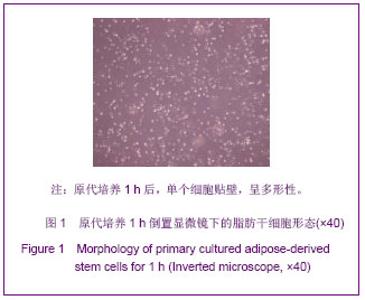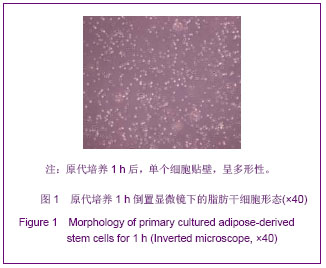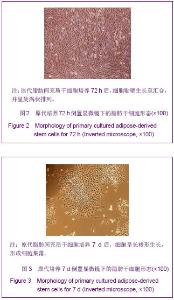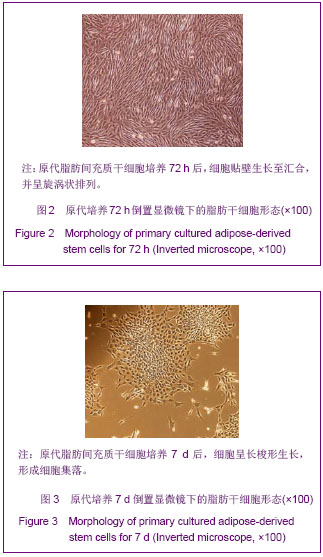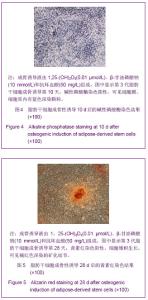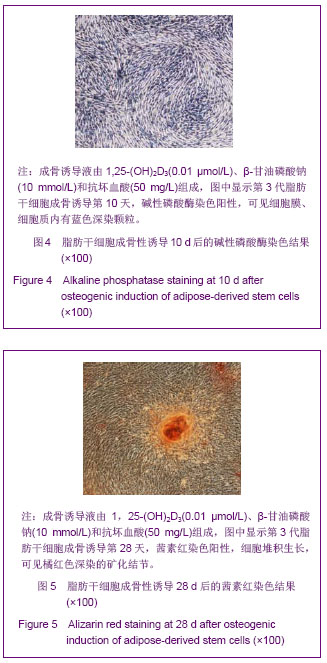| [1]Kilian KA,Bugarija B,Lahn BT,et al.Geometric cues for directing the differentiation of mesenchymal stem cells. Proc Natl Acad Sci U S A. 2010;107:4872-4877.[2]Tapp H, Hanley EN Jr, Patt JC, et al. Adipose-derived stem cells: characterization and current application in orthopaedic tissue repair. Exp Biol Med (Maywood). 2009;234:1-9.[3]Zuk PA,Zhu M,Mizuno H,et al.Multilineage cells from human adipose tissue: implications for cell-based therapies. Tissue Eng. 2001;7(2):211-228.[4]De Ugarte DA, Morizono K, Elbarbary A, et al. Comparison of multilineage cells from human adipose tissue and bone marrow. Cells Tissues Organs. 2003;174(3): 101-109.[5]Zachar V,Rasmussen JG,Fink T.Isolation and growth of adipose tissue-derived stem cells. Methods Mol Biol.2011;698:37-49.[6]Spencer ND,Chun R,Vidal MA,et al.In vitro expansion and differentiation of fresh and revitalized adult canine bone marrow-derived and adipose tissue-derived stromal cells.Vet J. 2012;191(2):231-239. [7]Rada T,Gomes ME,Reis RL.A novel method for the isolation of subpopulations of rat adipose stem cells with different proliferation and osteogenic differentiation potentials.J Tissue Eng Regen Med. 2011;5(8):655-664. [8]Uysal AC,Mizuno H.Differentiation of adipose-derived stem cells for tendon repair. Methods Mol Biol. 2011;702:443-451.[9]Lei F,Sun JJ,Liu Y,et al. Zhonghua Erbi Yanhou Toujing Waike Zazhi. 2010;45(7):587-591. 雷霏,孙建军,刘阳,等.大鼠体外培养脂肪干细胞对鼓膜成纤维细胞的影响[J].中华耳鼻咽喉头颈外科杂志.2012;47(6):466- 470.[10] Shuo G,Shuanhu Z,Julie G.Effects of 25-Hydroxyvitamin D3 on Proliferation and Osteoblast Differentiation of Human Marrow Stromal Cells Require CYP27B1/1α-Hydroxylase.J Bone Miner Res.2011;26(5):1145-1153.[11]Gloria A,Berta H,Daniel M,et al.Recruitment and subnuclear distribution of the regulatory machinery during 1α,25-dihydroxy vitamin D3-mediated transcription upregulation in osteoblasts.J Steroid Biochem Mol Biol.2010;121(1-2):156-158.[12]Van Driel DM,Pols HA,van Leeuwen JP. Osteoblast differentiation and control by vitamin D and vitamin D metabolites. Curr Pharm Des. 2004;10:2535-2555.[13]Fu JX,Wang PJ,Zhang XH,et al.Myeloma cells inhibit osteogenic differentiation of mesenchymal stem cells and kill osteoblasts via TRAIL-induced apoptosis.Arch Med Sci. 2010; 6(4): 496-504.[14]Anna I,Michael K,Ron S,et al.1,25(OH)2D3 Alters Growth Plate Maturation and Bone Architecture in Young Rats with Normal Renal Function.PloS One.2011;6(6):e20772.[15]Xuan Z,Jia S,Feng C,et al.NELL-1 Binds to APR3 Affecting Human Osteoblast Proliferation and Differentiation. FEBS Lett. 2011;585(15): 2410-2418. [16]Cao YL,Liu W,Zhang WJ,et al. Shanghai Jiaotong Daxue Xuebao: Yixueban. 2012;32(9):1241-1250.曹谊林,刘伟,张文杰,等.组织工程研究进展[J].上海交通大学学报: 医学版, 2012,32(9):1241-1250.[17]Li XJ,Wang WL,Liu HB. Sichuan Yixue. 2012;33(9): 1597- 1599.李小军,王文礼,刘海波.椎弓根钉系统固定结合经椎弓根自体骨移植治疗胸腰椎爆裂性骨折疗效分析[J].四川医学, 2012,33(9): 1597-1599.[18]Lin BW,Li WF,Wang H,et al. Zhonghua Guanjie Waike Zazhi. 2012;6(4):523-529.林博文,黎伟凡,王华,等.异体骨移植在髋关节翻修术中应用的10年随访[J].中华关节外科杂志,2012,6(4):523-529.[19]Zheng H,He SJ,Wang QB. Chuangshang Waike Zazhi. 2012; 14(2):130-132. 郑华,何盛江,王群波.锁定钢板加同种异体骨移植治疗老年肱骨近端骨折[J].创伤外科杂志, 2012,14(2):130-132.[20]Zhang DW,Tian QY,Liu GJ,et al.Zuzhi Gongcheng yu Chongjian Waike Zazhi.2012;8(1):26-31.张大伟,田清业,刘光军,等.骨膜瓣复合异体骨移植修复大段骨缺损[J].组织工程与重建外科杂志,2012,8(1):26-31.[21]Hu K,Liu B. Shengwu Guke Cailiao yu Linchuang Yanjiu. 2010; 7(3):32-38.胡堃,刘斌. 骨移植材料发展趋势[J]. 生物骨科材料与临床研究, 2010,7(3):32-38.[22]Wang YJ,Du C,Zhao NR,et al. Huanan Ligong Daxue Xuebao: Ziran Kexueban.2012;40(10):51-58.王迎军,杜昶,赵娜如,等.仿生人工骨修复材料研究[J].华南理工大学学报(自然科学版), 2012,40(10):51-58.[23]Min L,Liu LM,Song YM,et al.Zhongguo Guyuguanjie Waike. 2012;5(5):382-388.闵理,刘立岷,宋跃明,等.不同种类骨移植在青少年特发性脊柱侧凸后路矫形术中的中长期疗效评价[J].中国骨与关节外科, 2012, 5(5):382-388.[24]Li XY,Yao JF,Liu ZH. Zhongguo Zuzhi Gongcheng Yanjiu. 2012;16(27):4985-4990.李晓宇,姚金凤,刘政华,等.成骨诱导脂肪基质细胞在骨组织工程体内成骨中的作用[J].中国组织工程研究,2012,16(27): 4985-4990.[25]Qiao GY, Su JS. Kouqiang Hemian Waike Zazhi. 2010;20(5): 374-378.乔广艳,苏俭生.骨组织工程复合支架材料的研究进展[J].口腔颌面外科杂志, 2010,20(5):374-378.[26]Fang XK,Li GZ.Zhonghua Quanke Yixue. 2012;10(4):608- 609.方小魁,李光早.种子细胞在骨组织工程中的研究进展[J].中华全科医学, 2012,10(4):608-609.[27]Yao C,Bu LX,Wang K,et al. Huaxi Kouqiang Yixue Zazhi. 2012;30(3):229-233.姚超,卜令学,王科,等.应用细胞片层技术构建组织工程骨修复犬下颌骨缺损的实验研究[J].华西口腔医学杂志, 2012,30(3): 229-233.[28]Cherubino M,Marra KG. Adipose-derived stem cells for soft tissue reconstruction. Regen Med.2009;4(1):109-117.[29]Huang JI,Zuk PA,Jones NF,et al.Chondrogenic potential of multipotential cells from human adipose tissue.Plast Reconstr Surg. 2004;113(2):585-594.[30]Anghileri E, Marconi S, Pignatelli A, et al. Neuronal differentiation potential of human adipose-derived mesenchymal stem cells. Stem Cells Dev. 2008;17(5): 909-916.[31]Lei H,Li QF. Zhonghua Zhengxing Waike Zazhi. 2003;19(6): 465-466.雷华,李青峰.脂肪干细胞的研究进展[J].中华整形外科杂志, 2003,19(6):465-466[32]Mclntosh K,Zvonic S,Garrett S,et al.The immunogenicity of human adipose-derived cells:temporal changes in vitro.Stem Cells.2006;24(5):1246-1253.[33]Hsu LW,Goto S,Nakano T,et al.The effect of exogenous histone H1 on rat adipose-derived stem cell proliferation,migration,and osteogenic differentiation in vitro. J Cell Physiol. 2012;227(10):3417-3425. [34]Lopez MJ, Spencer ND.In vitro adult rat adipose tissue-derived stromal cell isolation and differentiation. Methods Mol Biol. 2011;702:37-46.[35]Zhang LH,Tang YJ,Liu JM,et al. Zhongguo Zuzhi Gongcheng Yanjiu yu Linchuang Kangfu. 2009;13(14):2685-2690.张丽华,汤银娟,刘杰明,等.大鼠附睾脂肪垫脂肪源性干细胞的分离培养及分化潜能[J].中国组织工程研究与临床康复,2009, 13(14):2685-2690.[36]Chen PP,Zhang LH,Dong WR,et al. Nanfang Yike Daxue Xuebao. 2011;31(3):512-517.陈盼盼,张丽华,董为人,等.脂肪组织源性干细胞分步诱导分化为神经元样细胞[J].南方医科大学学报,2011,31(3):512-517.[37]Hou K,Li M,Yang YK,et al.Zhongguo Zuzhi Gongcheng Yanjiu yu Linchuang Kangfu. 2011;15(1):29-32.侯凯,李梅,杨逸昆,等.SD大鼠脂肪源间充质干细胞分离培养特性及影响因素[J].中国组织工程研究与临床康复,2011, 15(1): 29-32.[38]Liang LH,Li L,Zhao JH,et al.Shiyong Kouqiang Yixue Zazhi. 2012;28(3):289-293.梁丽华,李龙,赵建辉,等.大鼠脂肪干细胞体外培养及成骨诱导分化研究[J].实用口腔医学杂志,2012,28(3):289-293.[39]Ju XD,Lu SQ,Tian H,et al.Zhonghua Shiyan Waike Zazhi. 2004;21(6):654-656.鞠晓东,娄思权,田华,等.脂肪间充质干细胞的基本生物学特性及向成骨细胞诱导分化的实验研究[J].中华实验外科杂志,2004, 21(6):654-656.[40]Zhang SL,Deng ZS,Li BJ,et al. Zhongguo Zuzhi Gongcheng Yanjiu yu Linchuang Kangfu. 2007;11(6):1022-1024.张胜利,邓展生,李宝军,等.大鼠脂肪间充质干细胞的成骨分化[J].中国组织工程研究与临床康复,2007,11(6):1022-1024. [41]Li DS,Li SQ,Cai B,et al. Zhongguo Zuzhi Gongcheng Yanjiu yu Linchuang Kangfu. 2011;15(14):2657-2660.李冬松,李叔强,蔡波,等.高糖及糖基化终末产物对人脂肪干细胞成骨分化能力的影响[J].中国组织工程研究与临床康复, 2011, 15(14):2657-2660. |
